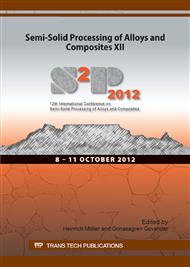p.323
p.329
p.335
p.341
p.347
p.353
p.359
p.365
p.373
On the Filling of Semi-Solid during Thixocasting
Abstract:
Thixoforming is a new forming technology which has been studied by many researchers during the last years. Mold filling is one of the most important steps for casting engineers which should be controlled to have a sound part. In the semisolid alloy forming die design, viscosity variations during forming and temperature decreasing, solid fraction plus globularity are the main parameters which affect final product. In this study, a stepped die was designed and some billets in different weights were injected into the die. This process helps to characterize the flow pattern during mold filling. The effect of two phase flow was also studied by microstructural investigating. Numerical simulation is the second method which is used in this study. The ProCast software was used to indicate the flow pattern of the fluid in the mold. Some comparisons were also done to show that this software is a suitable simulating software to predict the flow behavior of semisolid alloys. Also, the step casting method shows the exact pattern of flow in different parts of mold and is a reliable method for researchers to investigate the fluid pattern.
Info:
Periodical:
Pages:
347-352
Citation:
Online since:
October 2012
Keywords:
Price:
Сopyright:
© 2013 Trans Tech Publications Ltd. All Rights Reserved
Share:
Citation:


